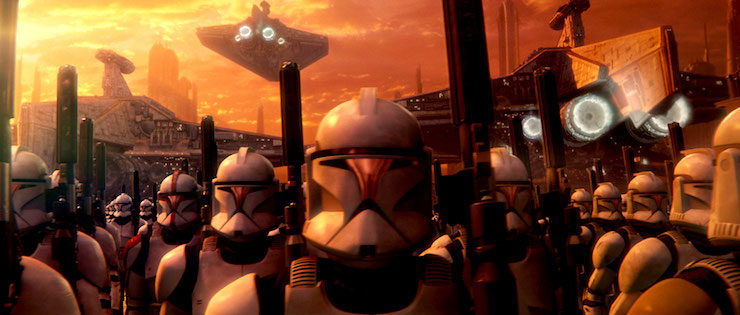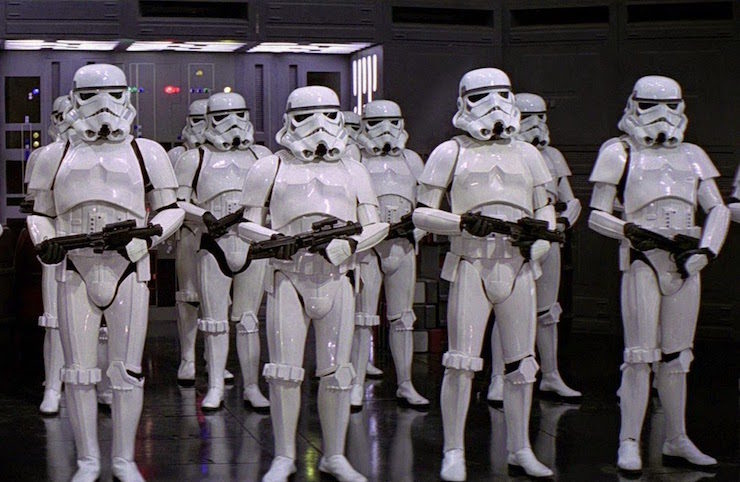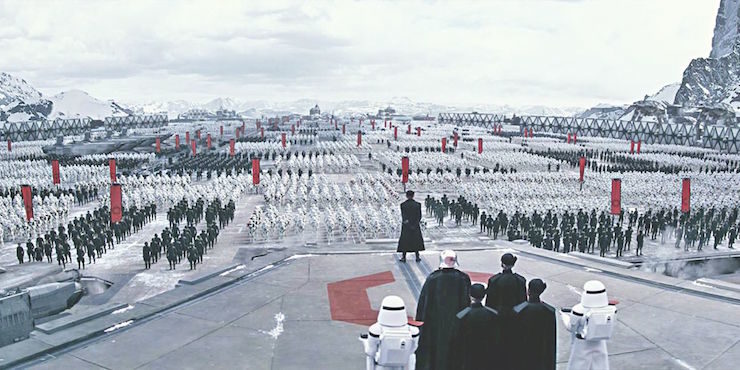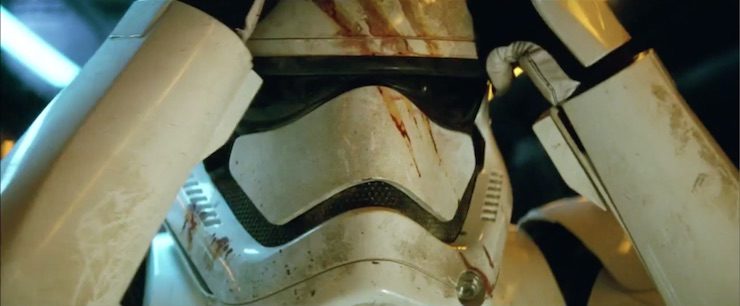There is a lot that we don’t know about the First Order in Star Wars. We don’t know precisely how it got started, how it grew, where all of its troops came from. We don’t know very much about Supreme Leader Snoke, or how the Knights of Ren tie into their hierarchy. We don’t know where all of those stormtroopers came from.
But we actually do know a little something about how they were programmed to stand against the Republic. And it’s not pretty.
According to Star Wars: The Force Awakens, the First Order is made up of stolen children. Finn tells Poe Dameron that he was taken from a family he has no memory of and made to serve, so it’s not as though the First Order keeps their recruitment policies a secret from their troops. Then how do they ensure loyalty to their cause? How do they make certain that stormtroopers never entertain thoughts of insurrection at knowing that they lost their family and all personal freedoms before they could ostensibly speak?
The answer lies in Before the Awakening, a book by Greg Rucka featuring a series of vignettes centered on the three main characters of The Force Awakens: Rey, Poe, and Finn. And it’s the former stormtrooper’s story that gives us insight into how the First Order operates, explicitly how it trains its military. Now, the idea of training grand armies that do terrible things is part of how the Star Wars universe operates, but with the First Order we see a different tactic altogether:
The First Order creates its army by having complete control over the information they have access to.
This might seem like a given to anyone who has ever studied fascism, but other armies in the Star Wars universe were built somewhat differently. The clone troopers of the prequel era were literally created to protect the Republic, programmed to do its bidding. (It is important to note that this was a possibility that the First Order entertained, as Kylo Ren makes clear when he chides General Hux over the potential fallibility of his training program for their armies–and that the start of Hux’s training program is given some extra and highly intriguing clarity in Chuck Wendig’s Aftermath: Empire End….) The clones were capable of learning a certain level of autonomy and they certainly had distinct personhood, but they were grown with suggestibility and docility built into their DNA, as it were; the Kaminoans take a moment to explain all of this to Obi-Wan Kenobi when he takes a tour of their facilities in Attack of the Clones. The men grown out of that program don’t require any form of ritual or methodical convincing that their job is the right one—it is literally the purpose of their existence.

While the Empire certainly used overblown propaganda to fuel their recruitment quotas, the choice to join them was optional, and the lie it was based upon only maintained for those who were willing to look the other way once their more horrific deeds came clear. The Empire maintained its ranks in tried and true fashion; it told its denizens lies that made them comfortable, so they were never questioned. It was helpful that the Empire was born out of a war that it won, disposing of the ineffectual Old Republic that was bogged down with minor political squabbles and already split apart by the Clone Wars. Citizens of the Empire wanted to the believe that their new government was good and just. It didn’t take much for the Empire to produce just the right sort of propaganda that would make the idea of joining up a patriotic, noble thing to do.
Claudia Gray’s Lost Stars does an excellent job of showing just how simple it was for the Empire to find willing recruits, and how long it might have taken for an enlistee to recognize the underlying terror of the Empire’s reign. Ciena Ree and Thane Kyrell are both kids on the Outer Rim world of Jelucan, which gets absorbed into the Empire. The two children were interested in the Imperial craft that brought Grand Moff Tarkin to their planet, sneaking around and eventually getting caught. After speaking to them personally, Tarkin recognized the intelligence of both children and planted the idea of them flying ships for the Empire, a means to engage in a subject they were passionate about. Both Ciena and Thane wound up going off to the Imperial Academy at the age of sixteen, training for years to become the best Imperial officers they could.

The Empire attempted to sabotage their friendship during their training to be certain that their loyalty was to the Empire rather than their homeworlds, a fact that the two only found out due to the drunken rambling of a fellow cadet—it had almost ruined their relationship entirely. But it wasn’t until repeatedly confronting the Empire’s atrocities—such as the Battle of Yavin and treatment of slaves on Kerev Doi—that Thane finally realized he had to desert the Empire. Ciena refused, believing that she could change it from the inside. So we see how the Empire manipulated their ranks into believing in their cause largely without rebuttal.
The First Order, on the other hand, created a closed system that prevented their soldiers from having any knowledge other than what they sanctioned. Finn, then referred to as FN-2187, was subjected to the same standard training that every First Order stormtrooper received. Unsurprisingly, during their downtime, First Order soldiers are only permitted to read “First Order-approved literature” or watch “First Order-approved vids.” They weren’t permitted enough time to speak to one another during meals; if they didn’t eat as quickly as possible, they didn’t get to eat at all. The food they were served barely had any flavor, and that was done purposefully. They studied former battles for tactics, many from the Clone Wars era, but often devoid of context and then recontextualized appropriately in the rest of their training.
In addition, twice-daily sessions of carefully produced propaganda—complete with shouting from Hux—were demanded of everyone:
There were mandatory morale sessions twice a day, when everyone was required to stop what they were doing and direct their attention to the nearest holoprojector to watch a recorded speech from High Command, most often from General Hux himself. Those would be interspersed with news feeds showing the deplorable conditions throughout the Republic: the famines on Ibaar and Adarlon, the brutal suppression of the population of Balamak, the unchecked alien advances throughout the Outer Rim. There would always be at least one story to follow about a First Order victory, the liberation of a labor camp on Iktotch or a fleet battle in the Bormea sector.
True to its name, the First Order tells its recruits that their job is to bring order to a lawless galaxy. The reason that assertion holds water is because there is no information offered to them that would indicate otherwise. In fact, the only reason that Finn starts to doubt is due to observations on his very first mission, directly before the start of Episode VII; he and his squad are deployed to a mining facility where they are meant to quell dissent that they’ve been told was caused by Republic saboteurs. (They never find evidence of those Republic agents.) Finn is the only one to notice what bad shape the alien miners are in, and what’s more, he’s the only one willing to note that they clearly cannot escape their situation:
“You could be a miner here,” FN-2187 said.
“Don’t make me laugh. We’re not supposed to laugh when in uniform, remember?”
“I’m not joking.”
“They could leave if they wanted to,” Slip said.
FN-2187 thought of the empty bay behind them, containing only the two transporters that had taken them and the other stormtroopers there. He didn’t say anything.
It’s hardly surprising that the other troopers don’t notice the distress of these workers because it goes against all information they’ve ever received throughout the course of their lives. Finn’s ability to see the lie makes him singular (possibly even Force sensitive?), and results in his defection. The First Order takes great care to suss out evidence of non-conformity and mentally wipe recruits that show signs of deviation from their norm. They can get away with this because they are responsible for every bit of news, history, and even fiction that their armies encounter. It makes sense of Hux’s over-the-top address before Starkiller Base’s destruction of the Hosnian System; speeches like that are part and parcel of the First Order’s typical daily rhetoric. There is no reason to distrust the mechanism because it is the only one that exists… and people have to get their information from somewhere, right?

In this manner, Star Wars has managed to highlight a present and pressing danger in the world—if our informative networks are eliminated, downsized, or discredited, we are in danger of missing the full picture. While severe in its execution, the First Order is disturbing peek into a closed system that actively punishes critical thinking and insists upon blind acceptance of an invisible status quo. The current threatening regime in the Star Wars universe is perhaps more relevant than it likely intended to be, and it’s a pointed jab at those who would insist upon controlling what information is accessible to all.
Emmet Asher-Perrin is really happy that she doesn’t have to eat First Order-approved meals. You can bug her on Twitter and Tumblr, and read more of her work here and elsewhere.










